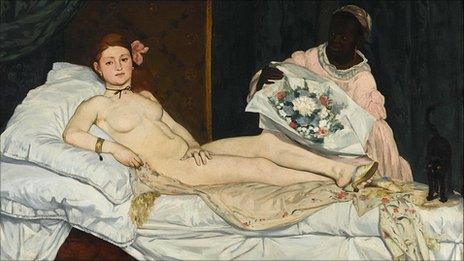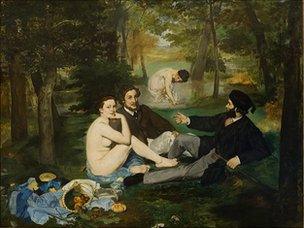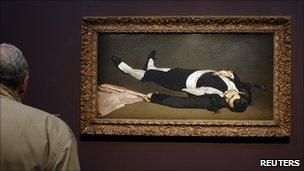Manet's ambition revealed at Paris exhibition
- Published

Olympia is one of Manet's most famous works
The Musee d'Orsay in Paris has just opened the biggest exhibition in France in decades of the work of the painter Edouard Manet.
The new show investigates what lay behind Manet's image as an elegant man-about-town.
Descriptions of Edouard Manet often resort to the untranslatable French term 'flaneur'.
In the late 19th century a flaneur was a well-to-do dandy, observing the city around him but always slightly distant from it.
Walking around the galleries at the Musee d'Orsay you can see why some art lovers find Manet a little reserved.
By and large his work lacks gorgeous blue skies and parasols and beach scenes - the sunny holiday scenes which make Impressionism such an easy sell.
Born in 1832 to a wealthy Parisian family, Manet steered clear of too much involvement with his Impressionist contemporaries, although the new show makes their mutual influence clear.
But it also reveals a titanic sense of ambition and a man intent on making a career in his own terms.

Le Dejeuner sur l'herbe (1863) is one of the most famous 19th century paintings
"To say Manet invented modernity in art is a cliche, but it's true," exhibition curator Stephane Guegan says.
"He wanted to refresh all the genres, whether it was the nude or the still life or the seascape. It's wrong to reduce him to just an influence on Impressionism, although he was that as well.
"I don't think there were any limits to his ambition."
Inevitably one of the big draws in the show will be his celebrated Le Dejeuner sur l'herbe (1863), one of the most famous 19th century paintings.
It was first seen at the Salon des Refuses, an exhibition of paintings rejected by the all-important Paris salon, the home of the French art establishment.
Manet's picture sent up the conventions of academic painting, showing a couple of students apparently enjoying the company of two young women among the trees.
But then the frank painting Olympia made Manet even more famous throughout Paris while still in his early 30s.
The model's nudity was thought shockingly blatant and the sexuality of her gaze unashamed. Most took it as a portrait of a prostitute.
British art historian Juliet Bareau has made a detailed study of Manet's work and has been to see the new exhibition.
"He was looking for new ways to express himself," she says. "He was hugely influenced by Velazquez in particular. He knew the academic mode of painting in France had become totally vacuous and out-of-date.
"When he finally had his first paintings accepted for the Salon in Paris, all the young artists and the hip literary crowd of the day were astounded.
"The pictures were so assured and had such clarity, they had a cleansing look which excited everyone."
Manet was only 51 when he died of syphilis in 1883, but the exhibition makes clear that in his later period he had learnt from the growing success of the Impressionists.
In the 1870s there is an obvious lightening of his colour palette which is partly down to their influence.
Bareau says he took from those slightly younger artists just as they took from him.
"He showed them they could get away from the subject matter that had been standard and go instead for something more straightforward and honest.
"But their painting had a new 'broken' touch which in turn influenced Manet.

The exhibition is on at the Musee d'Orsay until 3 July
"Throughout his career he had the same ability to express everything in terms of paint. It doesn't matter what he's painting - the marks he puts on canvass carry the emotion and the intention and the intellectual excitement.
"He just is a very great painter. Even the sketchiest work in the exhibition shows that," she says.
Not all of Manet's greatest hits are on the walls at the Musee d'Orsay - a fact which has annoyed one or two critics.
An obvious absence is the world-famous Bar at the Folies-Bergere, which remains at the Courtauld Gallery in London.
However Manet is a hugely popular artist and the show in Paris is bound to be a hit. It illustrates the powerful social and cultural changes in France in his lifetime.
And it confirms that Edouard Manet achieved his ambition to challenge art's worn-out conventions - and in doing so to become one of France's greatest painters.
Manet: the Man Who Invented Modernity is at the Musee d'Orsay in Paris until 3 July.
- Published23 June 2010